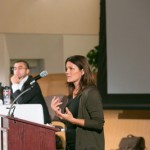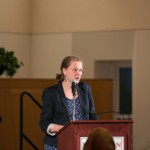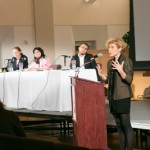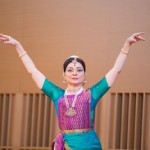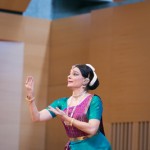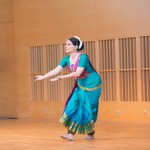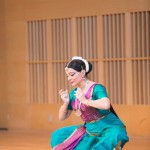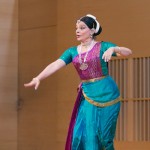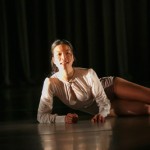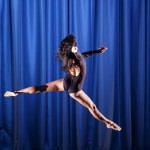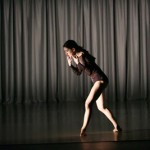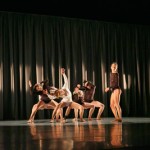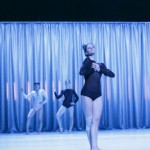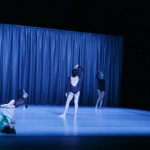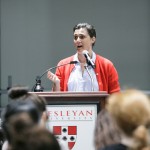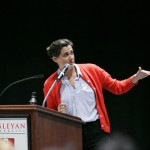A panel discussion exploring indigenous Ukrainian perspectives of Crimea post Russian-invasion took place on Friday, October 24, 2014, at Fayerweather Beckham Hall. Images by Sandy Aldieri of Perceptions Photography. Click here to view the full album on flickr.
Dance Department
Fall Photos: Malavika Sarukkai – Rasamanjari
Acclaimed dancer Malavika Sarukkai presented the New England premiere of Rasamanjari, a celebration of the classical dance language of India, as the conclusion of the 38th annual Navaratri Festival. Photos from the Sunday, September 28, 2014, performance at Crowell Concert Hall. Images by Sandy Aldieri of Perceptions Photography. Click here to view the full album on flickr.
Fall Photos: LeeSaar The Company – Princess Crocodile
“In its emotional nakedness, free-associative logic, and frank sensuality, the work of the Israeli-born couple Lee Sher and Saar Harari is inventive and arresting” (The New Yorker). The New England premiere of LeeSaar The Company’s Princess Crocodile was performed on Friday, September 19, 2014, in the CFA Theater. Images from dress rehearsal by Sandy Aldieri of Perceptions Photography. Click here to view the full album on flickr.
Fall Photos: Artist Talk – Faye Driscoll
“A startlingly original talent” (The New York Times), choreographer and director Faye Driscoll is a Creative Campus Fellow at Wesleyan during the fall of 2014, researching and developing “Thank You For Coming: Play,” one of a series of works she will be creating over the next several years. Photos from her artist talk on Thursday, September 11, 2014 in the Cross Street Dance Studio. Images by Sandy Aldieri of Perceptions Photography. Click here to view the full album on flickr.
Muslim Women’s Voices at Wesleyan: October Update
CFA Arts Administration Intern Chloe Jones ’15 discusses the events of “Muslim Women’s Voices at Wesleyan.”
Muslim Women’s Voices at Wesleyan is in full swing! We opened last month with the panel discussion Gender, Islam, and the “Muslim Problem,” organized and moderated by Professor of Religion Peter Gottschalk, followed by the Planet Hip Hop Festival. For those of you who were unable to attend the Planet Hip Hop Festival, or for those of you who were there and wish to see if you made it into the video, you can see exciting footage here.
Earlier this month, Muslim Women’s Voices at Wesleyan was featured on WNPR’s Where We Live with Center for the Arts Director Pamela Tatge joining Dr. Feryal Salem, Assistant Professor of Islamic Scriptures and Law, Co-Director of the Islamic Chaplaincy Program, and Director of the Imam and Muslim Community Leadership Certificate Program at the Hartford Seminary, and Sufi fusion singer Riffat Sultana (who will perform at Wesleyan on Friday, November 7, 2014 at 8pm). Click here to listen to the broadcast.

A number of exciting Muslim Women’s Voices at Wesleyan events are on the horizon. On Friday, October 24, 2014 at 8pm in the Memorial Chapel, Associate Professor of Dance Katja Kolcio presents the premiere performance of the multimedia work To Not Forget Crimea: Uncertain Quiet of Indigenous Crimean Tatars, a response to recent political changes in Crimea. Featuring live music and dance in collaboration with New York Crimean Tatar Ensemble Musical Director Nariman Asanov and Yevshan Ukrainian Vocal Ensemble Conductor Alexander Kuzma, the work explores issues of historical memory, cultural narrative, and the quest for human rights, as they relate to the history of Tatars, native inhabitants of Crimea, and their complex relationships with Ukraine and Russia. A free panel discussion, “Indigenous Ukrainian Perspectives of Crimea Post Russian-Invasion, will take place before the performance, on Friday, October 24, 2014 from 6pm to 7:30pm in Fayerweather Beckham Hall.
Next week, on Wednesday, October 29, 2014 at 7pm in CFA Hall, Lebanese American writer, actress, and teaching artist Leila Buck ’99 explores family, memory, and politics in her free solo performance Hkeelee (Talk to Me).
This semester, Ms. Buck is teaching a course in the Feminist, Gender, and Sexuality Studies Program Department, Beyond “the Veil”: Representations and Realities of Muslim Women in the U.S., as part of the Creative Campus Initiative. The course employs artistic methods, personal narratives, and in-person connection to research and examine the dominant representations of Muslim women in the U.S. mainstream media and the complex realities of Muslim women’s lives.
Ms. Buck will also give a free workshop performance (Friday, April 17 and Saturday, April 18, 2015 at 8pm), where she will present a work-in-progress showing of a collaborative theatrical work commissioned by the Center for the Arts as part of Muslim Women’s Voices at Wesleyan.
In the meantime, we hope you will join us for all of these upcoming talks and performances.
2014-15 Season Now On Sale! World, U.S., New England, CT Premieres
This year, we invite you to join us as we welcome the world to Wesleyan. Artists working in contemporary or traditional forms from 18 different countries will be performing or exhibiting at the CFA over the next nine months.
 A centerpiece of this year’s program is Muslim Women’s Voices at Wesleyan, which begins in September. Each of the performers to be featured is Muslim or of Muslim heritage, has a distinct set of personal experiences, and is embedded in a particular place, society, and cultural tradition. It is our way of inviting audiences to celebrate the complexity of Muslim women today, while at the same time exploring the historical and cultural context from which these women have emerged. We are also inviting audiences to participate in the creative process as we give birth to a new play by Leila Buck ’99, based on stories of Muslim and Muslim-American women in our region.
A centerpiece of this year’s program is Muslim Women’s Voices at Wesleyan, which begins in September. Each of the performers to be featured is Muslim or of Muslim heritage, has a distinct set of personal experiences, and is embedded in a particular place, society, and cultural tradition. It is our way of inviting audiences to celebrate the complexity of Muslim women today, while at the same time exploring the historical and cultural context from which these women have emerged. We are also inviting audiences to participate in the creative process as we give birth to a new play by Leila Buck ’99, based on stories of Muslim and Muslim-American women in our region.
We are also bringing one of the United States’ most innovative theater companies working at the intersection of text and technology, The Builders Association, for two performances in October. Their amazing production Sontag: Reborn is a portrait of the younger years of one of America’s most iconic intellectuals, Susan Sontag. In November, the Theater and Music Departments join forces to mount the Tony Award-winning musical In the Heights, directed by Theater’s Cláudia Tatinge Nascimento with music direction by Nadya Potemkina, director of the Wesleyan University Orchestra. The musical was the thesis production of Lin-Manuel Miranda, a Theater major who graduated in ’02, who went on to win the Tony for “Best Original Score.” The book was written by Quiara Alegría Hudes, winner of the Pulitzer Prize, who will be a visiting faculty member at Wesleyan this year. It is sure to be an extraordinary production. And throughout the fall, the epic-scale, haunting landscape paintings of Professor of Art Tula Telfair will be on view in Zilkha Gallery. We invite you to enter into the imaginary worlds that Telfair creates in twelve large-scale paintings that are simultaneously awe-inspiring and intimate.
We launched our new website over the summer, and we hope you’ll visit and return often to find out about all of the faculty, student, and visiting artist events and exhibitions this year. We hope you will look to us as a place of enlightenment and enjoyment in the coming months.
Pamela Tatge
Director
Center for the Arts
Three Different Capstones to the Wesleyan Experience (May 1)
CFA Arts Administration Intern Chloe Jones ’15 talks to graduate student Samuel Dickey ’14, and seniors Daniel Light ’14 and Emmie Finckel ‘14 about their capstone projects.
Wesleyan’s Center for the Arts offers undergraduate programs in Art & Art History, Dance, Music, and Theater, and graduate programs in Music. In every department, students have the opportunity to create a capstone project in their final year. These projects take myriad forms, each one a reflection of the student’s unique interests and creative voice.
On Thursday, May 1, 2014 at 9pm in Crowell Concert Hall, graduate student in music Samuel Dickey ’14 will present his thesis concert. After graduating from the Berklee College of Music in Boston, Mr. Dickey came to Wesleyan in pursuit of a Master of Arts degree in Ethnomusicology.
The two-year program does not require that students produce a concert, as not all ethnomusicologists play an instrument. Mr. Dickey, however, picked up his first guitar at the age of ten and hasn’t stopped playing since. In 2010 he learned to play the Jeli Ngoni, a string instrument from West Africa.
His thesis concert brings together musicians from the Wesleyan community and beyond, including a couple of his bandmates from New York City. Half of the performers are Wesleyan students.
In addition to the recital, Mr. Dickey’s thesis includes a written component of 75 pages. His essay examines the role of the guitar in West African music, and how this once foreign instrument became integrated into the performance of traditional songs. He is looking specifically at music produced on either side of the border between Mali and Guinea.
“Guitars have become a vehicle for translating traditional music into a more popular sphere,” he explains. “But more than the music being westernized by the guitar; the guitar has been Africanized by the music.”
Together, the essay and his recital mark the culmination of his studies at Wesleyan.
“The master’s program has been great,” says Mr. Dickey. “I think it will allow me to pursue the sort of foothold I’ve been after in the music world.”
After graduation Mr. Dickey hopes to attain an ensemble coaching position or become an artist-in-residence.
In addition to graduate students, many undergraduates in the Music Department produce recitals as their senior capstone projects. One such undergraduate is Daniel Light ’14, whose senior recital Resonance took place on Friday, April 18, 2014 in World Music Hall.
The Music Department grants its undergraduate majors a lot of flexibility in designing their senior projects. One student may choose to record an album, while another opts for making a musical.
Mr. Light began with a couple of songs that he had written and ultimately developed a set list of seven original numbers. He performed four of the songs with a full band, one with a string trio, one with a choral group, and one as a solo.
“It felt like a launching point,” reflects Mr. Light. “I remember thinking that I would like to do this again at some point, to use my own material to fuel a concert.”
Much like students in the Music Department, those majoring in Theater have the leeway to design a senior capstone project tailored to their interests. This past November, as part of her thesis, Emmie Finckel ‘14 designed the set for the Theater Department’s production of Anton Chekhov’s The Seagull.

Envisioned as a theater prop house gone to ruin, the set filled the enormous stage in the CFA Theater with furniture and other objects. The audience watched the performance from the stage, immersed in the set alongside the actors.
The hands-on work that Ms. Finckel did for The Seagull comprised the first part of her thesis. The second part is an essay of 30 to 40 pages, in which she examines audience agency in immersive theater design.
Ms. Finckel’s thesis gave her the opportunity to work closely with faculty members, including Associate Professor of Theater Yuri Kordonsky, who directed the production, and Assistant Professor of Theater Marcela Oteíza, who has become a mentor to Ms. Finckel in her time at Wesleyan.
“It was wonderful to feel like they respected me enough to want me to be involved [in The Seagull] as their collaborator,” recalls Ms. Finckel.
Dramatically different in approach and content, these three examples of capstone projects speak to the wide-reaching interests of Wesleyan students and their impulse to innovate and create. The capstone programs provide students an opportunity to synthesize the experiences that they’ve had at Wesleyan, reflecting both on where they’ve been and where they can go.
Spring Faculty Dance Event Feeds the Community (April 25 & 26)
CFA Arts Administration Intern Chloe Jones ’15 talks to Associate Professor of Dance Nicole Stanton about her commissioned work “Threshold Sites: Feast.” This Spring Faculty Dance Event will take place on Friday, April 25 at 7pm, and Saturday, April 26, 2014 at 2pm and 7pm in the new Cross Street Dance Studio, located at 160 Cross Street in Middletown.
Social media such as YouTube and Facebook have all but eliminated formerly unbridgeable distances between people and communities across the world. We are more connected today than ever before.
Coupled with growing concern for the environment, our increased connectivity demands that we reconsider our understanding of community. What does it mean to be part of a community? How can we foster local communities in an increasingly globalized world? How can human communities exist in harmony with nature?
The notion of community is central to this year’s Spring Faculty Dance Event. Created and directed by Associate Professor of Dance Nicole Stanton, Threshold Sites: Feast explores the relationships between bodies, communities, and environments through the lens of food.
“Something about the way you live in and experience your body is related to the way you live in and relate to your community and your environment,” says Ms. Stanton.
Food relates to it all. We eat to nourish our bodies, come together to break bread, and depend on the earth for our food. Food sustains every life, family, and community.
In recent years, food has become a hot topic of debate and conversation.
“There is so much controversy surrounding food production and food security right now,” says Stanton. “So much talk about what diet is good for you and for the planet.”
Threshold Sites: Feast is the culmination of Ms. Stanton’s engagement in the College of the Environment’s 2013-2014 Think Tank: Re-Envisioning the Commons. Over the course of this school year, the Think Tank has made efforts to expand discourse between economists, scientists, ecologists, and ethicists by bringing the humanities and performing arts into the conversation.

Ms. Stanton will perform in the work alongside Rachel Boggia, Deborah Goffe, Nik Owens ’12, and Wesleyan Artist in Residence in West African Dance Iddi Saaka. They are a diverse group, with backgrounds in myriad dance forms and roots across the globe.
“It was an extremely collaborative process,” says Ms. Stanton. “The question being how do all these different bodies come together in a process that feels full and rich and challenging to everyone.”
As part of the rehearsal process, Ms. Stanton prompted all of her dancers to reflect on their personal and shared experiences with food. They collected stories about memorable meals and songs about feasting — weaving many voices together into one rich sound score that backgrounds the event.
Some of the foods discussed in the sound score, many of them cherished family recipes, will be served to the audience. Yes, there will be literal feasting.
Ms. Stanton intends to source some of the food from Wesleyan’s own Long Lane Farm. Greg Foley ’16 has been collaborating with Ms. Stanton on a documentary, which parallels the rehearsal process for Threshold Sites: Feast with the process of getting the farm up and running.
Threshold Sites: Feast will be the first performance to take place in the Wesleyan Dance Department’s new studio on Cross Street. Formerly the A.M.E. Zion Church, the building has been remodeled into a beautiful dance studio that can also be converted into a black box theater.
Spring Faculty Dance Event
Threshold Sites: Feast
Friday, April 25, 2014 at 7pm
Saturday, April 26, 2014 at 2pm & 7pm
Cross Street Dance Studio
$3 Wesleyan students, $5 all others.
Supported by the Dance Department, the Center for the Arts’ Creative Campus Initiative with leadership funding from The Andrew W. Mellon Foundation, and the College of the Environment.
Music/Movement Residency Comes to a Close with “Living in Song” Showing (April 17)
CFA Arts Administration Intern Chloe Jones ’15 talks to Claire Marshall ’17, Trouve Ivo ’15, Alma Sanchez-Eppler ’14, and CFA Programming Intern Francesca Miller ’14 about the “Living in Song” residency workshops. Participants from the workshops will perform song, movement, and sign language in a free celebratory concert on Thursday, April 17, 2014 at 7pm in Crowell Concert Hall.
Three members of the Grammy Award-winning African American female a cappella ensemble Sweet Honey in the Rock® [currently celebrating their 40th anniversary season] have been in residence at Wesleyan over the past month. They’ve been teaching three different workshops for 65 Wesleyan students and Connecticut residents. The workshops have been held at the Cross Street A.M.E. Zion Church, the Green Street Arts Center, and in the Fayerweather Dance Studio on campus.

In “The Vocal Movement Experience” workshops, Dr. Nitanju Bolade Casel shows participants how movement and breath can serve as a catalyst for sound. Dr. M. Louise Robinson leads “The Rhythm Ring,” workshops designed to spark musical conversation in the oral tradition of call and response. Those in Dr. Shirley Mary Childress’ “Songs in the Way of Hand” workshops learn to understand and communicate songs visually using the vocabulary of American Sign Language.
Although each of the “Living in Song” workshops has a unique focus, they all center on ideas of community. Part of the mission of Sweet Honey in the Rock® is to engage with and empower its diverse audience. Dr. Casel, Dr. Robinson, and Dr. Childress have achieved just that with their “Living in Song” workshops.
“Looking around the room and recognizing our different backgrounds has been really empowering to me,” says Claire Marshall ’17. “It’s been a chance to drop into a world where people don’t all come from the same place.”
The workshops provide a unique opportunity for Wesleyan students to learn alongside Middletown residents. There are participants commuting from other parts of Connecticut as well, including a few women who sing in a choir in Hartford.
“It’s a lot more about the community than about us Wesleyan students,” says Trouve Ivo ’15.
“The group is incredibly diverse and it has been wonderful to play in this way,” comments Alma Sanchez-Eppler ’14.
A couple adults are participating alongside their home-schooled children, further broadening the age range of the workshops. “The children are super enthusiastic,” says CFA Programming Intern Francesca Miller ’14.
Playful and enthusiastic seem to describe the general mood of the workshops. “Everyone is always super excited to be there,” describes Mr. Ivo.
The energy cultivated in the workshops is radiant, and participants are bringing what they’ve learned into the community. Two Wesleyan students are taking the “Songs in the Way of Hand” workshops as a way to become familiar with deaf culture in anticipation of living in Sign House next year.
The “Living in Song” workshops speak to the power of song to foster community, all the while honoring the voice of the individual.
“I’ve grown to be more comfortable with using my own voice and using song to bring a group together,” reflects Mr. Ivo. “Vocal expression should be more present in creative communities because it’s a really incredible, uniting thing.”
Living in Song Showing
Thursday April 17, 2014 at 7pm
Crowell Concert Hall, 50 Wyllys Avenue, Middletown
FREE!
Made possible by Wesleyan’s Office of Equity and Inclusion.
Spring Senior Thesis Dance Concert Speaks to Students’ Unique Interests (Apr. 3-5)

CFA Arts Administration Intern Chloe Jones ’15 talks to Sierra Livious ’14 and Emily Weitzman ’14 about the Spring Senior Thesis Dance Concert (Thursday, April 3 through Saturday, April 5, 2014 at 8pm). All performances are sold out.
Tickets are sold out for this week’s Spring Senior Thesis Dance Concert. Featuring original works by six graduating seniors, the performances mark the culmination of their time in the Wesleyan Dance Department.
For those completing a thesis, this concert has been a year in the making. The dance thesis requires approximately twenty minutes of choreography, divided between a fall and spring concert, as well as a research paper between 60 and 100 pages. Others are doing senior projects, which entail a semester-long research engagement and an abbreviated number of choreographed minutes and written pages.
The performances will be held in the Patricelli ’92 Theater [located at 213 High Street], followed by a site-specific work at Alpha Delta Phi [located at 185 High Street]. The concerts will cover a lot of ground — the dances are a reflection of the unique and varied interests of the choreographers.
The concert opens with a piece by Sally Williams ’14. Also majoring in Molecular Biology and Biochemistry, her thesis examines the intersection between the dancing body and the diseased body with a focus on Alzheimer’s and Dementia.
In the dimly lit theater, while dancers wait in the wings, a glowing MRI scan of a deteriorating human brain is projected onto the floor of the stage. What follows is an arresting display of dancing bodies, caught in the act of remembering and forgetting. Their movement is gestural and disoriented, ethereal and detached.
Another choreographer, Sierra Livious ’14, designed her own University major, which brings together Neuroscience, Biology, and Dance to study movement analysis or kinesiology. Influenced by artists such as Irene Dowd and Andrea Olsen, her research focuses on the efficiency of goal-oriented movement through the lens of dance.
“Thinking of the body as a machine,” Ms. Livious elaborates, “I wanted my dance to explore the relationships between elements of the body.”
Ms. Livious hopes to further develop her research after graduation, focusing on real world applications of the ideas she’s exploring in her senior project. Interested in injury prevention, she intends to pursue a career in physical therapy.
Also majoring in English, Emily Weitzman ’14 is writing a non-fiction thesis about her experience at a medical clinic in Mombasa. She became fascinated with the waiting room in the clinic, as a site of both movement—people passing through and strolling by—and stillness, waiting.
Her interest in the waiting room prompted her to choreograph a piece about place, or rather “non-place.” A non-place is somewhere that exists only for one to leave it — an airport, for example, or a bus stop.
“It’s about the non-place as it relates to home,” explains Ms. Weitzman. “It’s about how people can be home, places can be home, objects can be home.”
At once playful and profound, the piece features three dancers and two wooden benches. The trio moves and manipulates the benches in the most inventive ways—climbing on them, crawling under them, flying off them—so that the benches seem to also dance. It’s as if the benches become the dancers and the dancers become the benches.
Another piece [by Elle Bayles ’14] draws inspiration from Merce Cunningham and Pina Bausch to explore how modern dance and psychology both offer opportunities for self-reflection and ways of understanding the human experience. Another [by Naya Samuel ’14] poses current yet timeless questions about socially constructed identity, personal history, and perspective.
For the final piece [by Emily Jones ’14], the audience is ushered from the Patricelli ’92 Theater to the nearby Alpha Delta Phi house for a site-specific work influenced by Punchdrunk’s production of Sleep No More. The dance takes place throughout the house and viewers are free to roam, so that it’s the steps each audience member takes that determine what they see and where.
Together these six stand-alone pieces make for a diverse concert rich with movement and meaning.


